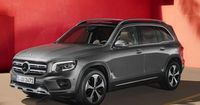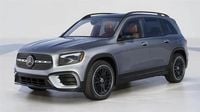Mercedes-Benz India has officially discontinued its GLB seven-seater SUV, marking the end of an era for one of the brand's most accessible luxury vehicles in the country. Launched in December 2022, the GLB was positioned as an entry-level luxury SUV and was notable for its three-row seating configuration, catering to families and those seeking a premium driving experience.
The GLB was imported as a completely built unit (CBU), which contributed to its higher price point, with an ex-showroom cost ranging from ₹63.80 lakh to ₹69.80 lakh. Despite its appealing design and features, the GLB struggled to achieve significant sales, leading to its discontinuation. All units allocated for the Indian market have now been sold out, and the vehicle has been delisted from the brand’s official website.
Mercedes-Benz offered the GLB in three variants: the GLB 200, GLB 220d, and GLB 220d 4MATIC. The GLB 200 was equipped with a 1.3-litre four-cylinder petrol engine, producing 161 bhp and 250 Nm of torque. The diesel variants, GLB 220d and GLB 220d 4MATIC, featured a more robust 2.0-litre four-cylinder engine that delivered 188 bhp and 400 Nm of torque. All models were paired with an eight-speed automatic transmission, while the 4MATIC variant provided all-wheel drive capabilities.
Despite its unique positioning in the luxury car market, the GLB faced challenges that ultimately led to its downfall. Many buyers found the third row of seats to be impractical, primarily suitable for children, which diminished the vehicle's appeal as a family SUV. As a result, potential customers often opted for larger and more powerful models like the GLE or even competitors such as the BMW X5.
Globally, the GLB received a mid-life update in 2023, which included cosmetic enhancements such as redesigned bumpers, new alloy wheels, and revised lighting elements. The facelift also introduced updated upholstery options and a new steering wheel design, along with dual 10.25-inch digital displays as standard. A significant mechanical upgrade was the addition of 48-volt mild-hybrid technology across both petrol and diesel variants, aimed at improving efficiency and performance. However, this updated version was not launched in India, which may have further affected its sales.
Interestingly, the electric counterpart to the GLB, the EQB, remains available in India, continuing to align with Mercedes-Benz’s strategy of electrification. The EQB is priced between ₹72.20 lakh and ₹78.90 lakh, indicating a commitment to offering electric options in the luxury segment.
While the GLB may not have achieved the sales figures Mercedes-Benz anticipated, it did carve out a niche for itself among buyers looking for a compact luxury SUV with three rows of seating. Its boxy design and spacious interior offered a rare blend of form and function in the premium SUV segment.
Mercedes-Benz has not officially stated the reasons for the GLB’s discontinuation, but industry experts speculate that weak sales were a significant factor. The discontinuation of the GLB does not signal the end of Mercedes-Benz's presence in the luxury SUV market, as the company is reportedly working on a next-generation GLB, which is expected to debut in India after the launch of the new third-generation CLA sedan, anticipated by the end of 2025.
As the GLB exits the market, consumers are left wondering what the future holds for Mercedes-Benz’s lineup in India. The company’s focus on electric vehicles and upcoming models may reshape the luxury SUV landscape in the country. The GLB’s departure highlights the competitive nature of the luxury automotive market, where consumer preferences are continually evolving.
In summary, the discontinuation of the Mercedes-Benz GLB in India marks a significant shift for the brand, as it navigates the complexities of consumer demand and market competition. The GLB was a promising entry into the luxury SUV segment, yet it ultimately could not sustain the momentum needed for long-term success.








